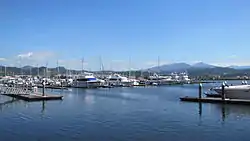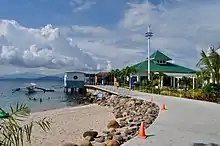Subic Special Economic and Freeport Zone
Subic Special Economic and Freeport Zone, which is known simply as Subic Bay or Subic is a special economic zone and freeport area covering portions of Olongapo City and the towns of Subic in Zambales and Morong and Hermosa in Bataan.[1] The relatively developed and fenced area is called the Subic Bay Freeport Zone (SBFZ).
Subic | |
|---|---|
| Subic Special Economic and Freeport Zone | |
 Subic Bay Yacht Club | |
.svg.png.webp) Subic Location within the Philippines | |
| Coordinates: 14.807°N 120.287°E | |
| Country | |
| Region | Central Luzon (Region III) |
| Province | Zambales, Bataan |
| City and municipalities | |
| Founded | November 24, 1992 |
| Founded by | Republic Act No. 7227 |
| Government | |
| • Chairperson and Administrator | Wilma Eisma |
| Time zone | UTC+8 (PST) |
| ZIP code | 2222 |
| IDD : area code | +63 47 |
| Website | Subic Bay Freeport Official Website |
The site of the economic zone was formerly the location of the U.S. Naval Base Subic Bay. The economic zone is operated and managed by the Subic Bay Metropolitan Authority (SBMA). The harbor faces the Zambales Mountain Range to the west and the Subic Bay opening to the South China Sea.
History
Subic Bay is surrounded by the town of Subic and Olongapo City, both in the province of Zambales, and Morong in the province of Bataan. Development of Olongapo City was largely tied to the presence of the United States Navy base, once the largest U.S. military naval base in Asia. An arsenal and ship-repair facility was established at Subic Bay in 1885 by the then colonial power, Spain. Following the Spanish–American War, Subic Bay became a U.S. Navy and Marine base, and grew to be a major facility. Until 1991, it was the base of the United States 7th Fleet.
.svg.png.webp)
In early 1991, after the collapse of protracted negotiations, the Philippine Senate rejected terms for renewal of the lease of the base. The U.S. Navy was already in the process of downsizing its Subic operations in June 1991, when Mount Pinatubo erupted. One of the largest volcanic eruptions in the last 100 years, it covered the Navy Base in volcanic ash and collapsed a significant number of structures. The last ship, USS Belleau Wood, left on November 24, 1992. The presence of the American forces precipitated the start of a red-light district.[2]
Post–Cold War
Subic Bay was converted into a commercial zone largely through the efforts of some 8,000 residents of nearby Olongapo City, under the leadership of their mayor, Richard Gordon, who volunteered to protect and preserve 8 billion dollars worth of facilities and property from looting and destruction. Subic has since been transformed and became a model for bases conversion into commercial use after the Cold War with blue chip companies like Coastal Petroleum, and Fed Ex pumping in over $3 billion of investments creating 70,000 jobs in the free port's first four years. It was host to the 4th APEC Leaders' Summit on November 24, 1996[3] and FedEx's Asia-Pacific hub, Asia-One, was also located in Subic Bay for almost ten years.[4][5]
In 2013, Defense Secretary Voltaire Gazmin said that the Philippines intended to move military forces to the base in response to the territorial disputes in the South China Sea.[6] The United States Navy is also seeking access on a rotational basis for ships and Marines,[7] and is already conducting maritime patrol aircraft patrols from bases in the Philippines.[8]
Geography
While the Subic Special Economic and Freeport Zone shares name with a town of the same name, it actually covers portions of Olongapo and the towns of Subic in Zambales and Morong and Hermosa in Bataan. It covers a total area of 67,452 hectares (166,680 acres), but only 14,000 hectares (35,000 acres) area is secured and fenced where much of the development in the special economic zone has taken place. This area is referred to as the Subic Bay Freeport Zone and out of this area 2,800 hectares (6,900 acres) is suitable for development with the remaining portions consisting of high slopes, forests, or protected areas. In 2017. negotiations with local government units contiguous to the Subic Bay Freeport Zone began to have the fenced area expanded.[1]
The special economic zone is also adjacent to a body of water, the Subic Bay. There are also at least six mangrove areas in the Freeport Zone.[9]
Economy

In mid-2019, there are about 135,000 workers employed in the Subic Bay Freeport, 68.37 percent of which are engaged in the service industry and 17.03 percent in the manufacturing industry. Subic was also a hub in shipbuilding, with the now-defunct Hanjin Philippines previously being the single biggest employer in the area prior to its bankruptcy in January 2019. As of mid-2019, there are 5,901 workers or (4.36 percent) employed in the shipbuilding and maritime industry from 96 firms compared to 26,559 workers from 110 companies in 2018.[10] Subic is served by the Port of Subic.
Tourism

In addition to commercial use, Subic Bay is also a popular destination for weekend visitors from Metro Manila. Attractions include several beaches, an underwater aquarium, jungle survival tours, and duty-free shopping centers.
Destinations frequented by tourists in Subic includes eco-tourism theme parks, the Ocean Adventure,[11] Zoobic Safari,[12] and the Pamulaklakin Nature Park[13] which is home to the indigenous Aetas who once trained the U.S. Navy in jungle survival tactics.[14]
Subic International Raceway (SIR), the Philippines' first purpose-built motorsports venue, was opened in 1994 and situated near Subic Bay International Airport. It was established by local racing champion, Pocholo Ramirez, and his family. SIR was host to international racing events, such as the Asian Festival of Speed, Asian Formula 2000 and the Asian Formula Three Championship.[15] It also hosted local races, such as the Philippine Touring Car Championship, Run What You Brung (RWYB) and Circuit Showdown. The racetrack ceased operations in 2010 after the end of its lease.[16]
Transportation
The Subic Special Economic and Freeport Zone is served by the Subic–Clark–Tarlac Expressway. Subic is also the site of the Subic Bay International Airport which could be used for chartered flights. The airport was also a former Asian hub of multinational logistics company FedEx. The Port of Subic also serve direct passenger traffic through ferries going to and from Orion, Bataan.[17]
Industrial Park
Most of the businesses inside the Freeport Zone are composed of manufacturing, construction and warehousing. the operation of the freeport zone allow to invest are subdivided into industrial park namely:
- Subic Bay Gateway Park (formerly Subic Bay Industrial Park)
- Subic Techno Park
- Global Industrial Park (SRF Compound)
- Boton Lights and Sciences Park
References
- Empeño, Henry (31 January 2017). "SBMA plans extending Subic Freeport to contiguous towns". BusinessMirror. Retrieved 6 January 2020.
- Marquardt, Alexander; Waterfield, Alex (25 February 2013). "Alleged Underage Prostitution in Philippines; Americans Targeted". ABC News. Retrieved 31 January 2019.
- "Asia-Pacific Economic Cooperation". www.apec.org. Retrieved 2017-05-05.
- "FedEx - About FedEx - Press Releases". www.fedex.com. Retrieved 2017-05-05.
- Cruz, Ed Michael Lee. "Brief History". Official Website of the Subic Bay Metropolitan Authority. Retrieved 2017-05-05.
- "Manila to move air force, navy near disputed sea ."
- "Navy wants to expand Philippine presence, create temporary base."
- "It’s Boom Time for Naval Spy Planes"
- Mallari, Rhea Jane; Alcazar, Lilia. "State of the Mangroves in Subic Bay Freeport Zone". 2014: State of the Mangrove Summit: Northern Luzon Proceedings: 23–28. Retrieved 6 January 2020.
- Empeño, Henry (11 September 2019). "Subic work force back at 135,000 despite closure of Hanjin". BusinessMirror. Retrieved 6 January 2020.
- "About Us – Ocean Adventure". www.oceanadventure.ph. Retrieved 2017-05-05.
- "Fast Facts About Zoobic Safari | Zoobic". zoobic.com.ph. Retrieved 2017-05-05.
- "Pamulaklakin Forest Trail (Subic Bay Freeport Zone, Philippines): Top Tips Before You Go - TripAdvisor". www.tripadvisor.com.ph. Retrieved 2017-05-05.
- Waddington, Ray. "Indigenous Peoples of the World — The Aeta". www.peoplesoftheworld.org. Retrieved 2017-05-05.
- "Improved Subic International Raceway bows this April"
- "The Last Lap of Subic Raceway"
- "Getting to Subic Bay". My Subic Bay. Subic Bay Metropolitan Authority. Retrieved 6 January 2020.
External links
- Subic Bay (Freeport) Metropolitan Authority (SBMA) official website
- The Official Tourism Website for the Subic Bay area, containing tourist and accommodation information (Authorized by SBMA)
- The Subic Bay Story: Rising Above The Storm
- Satellite photo, March 2004
- THE SUBIC STORY—One Community’s Response to the Challenge Of Change and Development (Philippine Secretary of Tourism 2002)